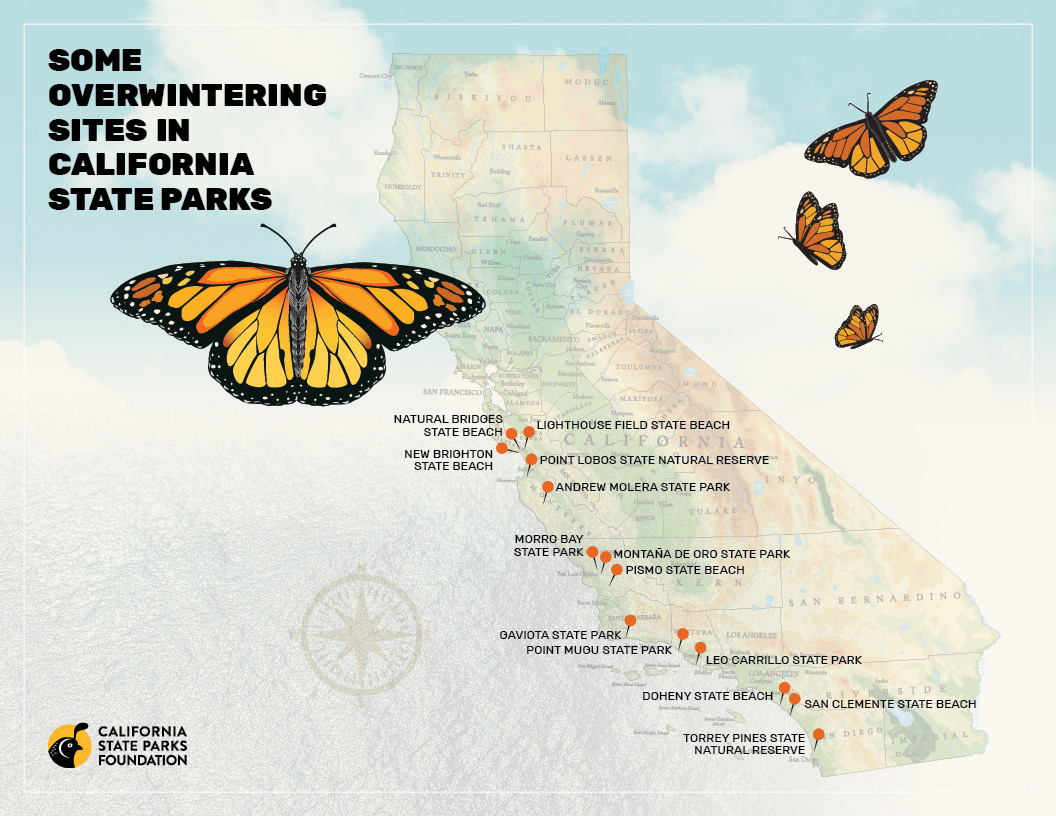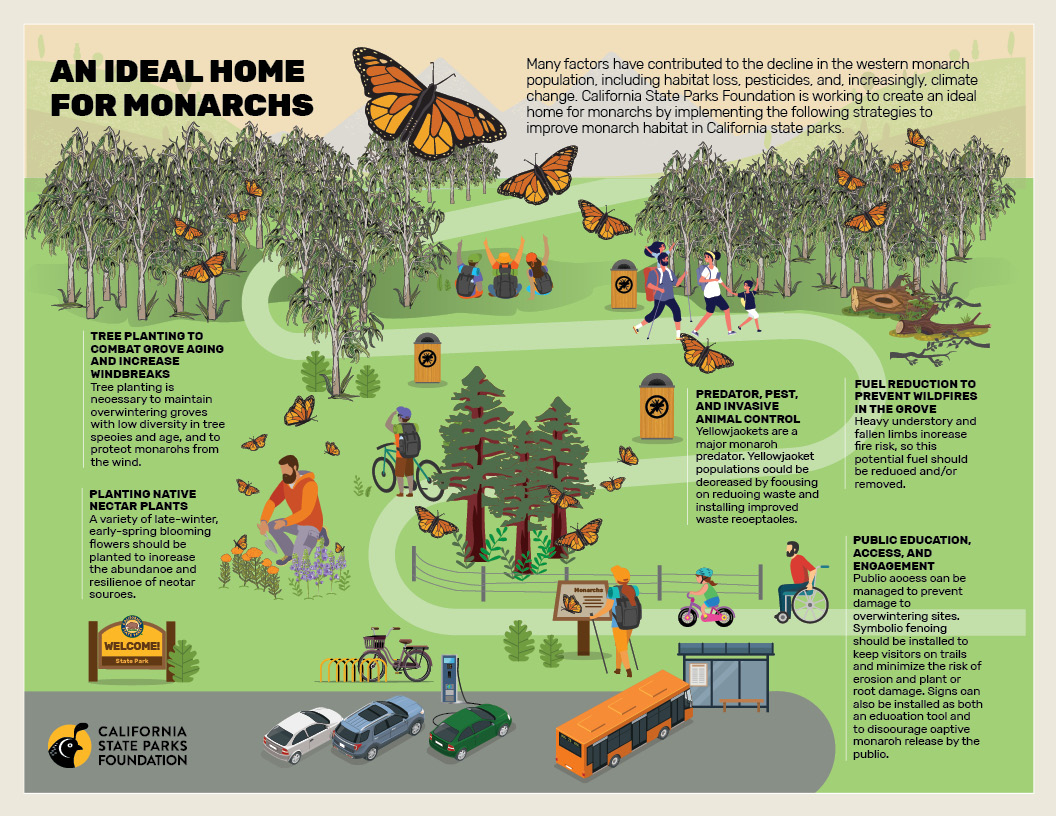The monarch butterfly is one of most recognizable and charismatic butterflies in North America. Monarchs are known for their vibrant orange and black wings and their unique long-distance, multi-generational migration cycle. Western monarchs migrate from around the Western United States to California and gather in coastal overwintering habitats, largely within California state parks, during the winter.
What is an overwintering site?
Overwintering sites provide a specific microclimate for monarchs in diapause — a period similar to a bear’s hibernation — when their activities are limited to sunning, rehydrating, and feeding on nectar. This microclimate includes dappled sunlight, high humidity, fresh water, and the absence of freezing temperatures or high winds. These sites are typically within 1.5 miles of the Pacific Ocean’s coast or San Francisco Bay, both of which regulate site temperature and supply fog as a water source. They are usually at low elevations (60-90 meters) and on slopes oriented south, southeast, or west for maximum solar radiation. Sites are also found in shallow canyons and gullies, and they are located near abundant nectar plants to provide monarchs with a constant nutrition source.
Overwintering sites in California state parks
California State Parks is the largest single overwintering site landowner and manages 25 of the 246 overwintering populations. Overwintering sites in California state parks hosted 29% of all western monarchs in 2018. In 2019, this number increased to 44%, with Pismo State Beach and Lighthouse Field State Beach hosting the first and second largest populations, respectively. In 2020, California state parks harbored three of the top 10 overwintering populations (Pismo State Beach, Lighthouse Field State Beach, and Natural Bridges State Beach), representing 45% of western monarchs. In 2021, Natural Bridges State Beach alone held the largest number of overwintering western monarchs, comprising 28% of the total population.
Because California state parks host the majority of overwintering monarchs, preserving and restoring these sites is essential to maintaining the western monarch population.
Overwintering Grove Management Plans; an essential step for monarch conversation
An overwintering grove management plan is essential to effectively conserve and restore overwintering monarch habitat. These plans outline strategies for forest and land management, pest control, environmental concerns, and public engagement.
Landowners, like California State Parks, develop a unique plan for each overwintering site to identify specific concerns and management techniques for that location. They evaluate future threats such as sea level rise at coastal sites and develop a strategy to address these challenges. Management plans must be adaptable to account for aging groves and a changing climate.
Overwintering grove management plans have been developed for several sites in California state parks. Several of these plans were funded by California State Parks Foundation through grants made possible by members and donors who gave to the 2021 monarch conservation campaign.
An ideal home for monarchs – our next step
To help reverse the western monarchs’ downward population trend, we need to improve protection and management of the butterfly’s habitat. Many factors have contributed to the decline in the western monarch population, including loss of overwintering and breeding habitat, loss of nectar sources, increased pesticide use, and natural enemies and disease. Climate change also posing an increasing threat that needs immediate attention and should be included in all future conservation plans. California State Parks Foundation is working to create an ideal home for monarchs in California state parks by implementing the following strategies to improve monarch overwintering habitat.
Donate this Giving Tuesday to help support monarchs and the state parks they rely on! Your gift today will ensure that everyone can enjoy this iconic species and parks for generations to come.
Sources:
Anderson and Brower, 1996 -- https://resjournals.onlinelibrary.wiley.com/doi/abs/10.1111/j.1365-2311.1996.tb01177.x
Calvert and Cohen, 1983 -- https://resjournals.onlinelibrary.wiley.com/doi/abs/10.1111/j.1365-2311.1983.tb00525.x
Chaplin and Wells, 1982 -- https://resjournals.onlinelibrary.wiley.com/doi/10.1111/j.1365-2311.1982.tb00664.x
Herman, 1981 -- https://www.journals.uchicago.edu/doi/abs/10.2307/1540903
Leong, 1990 -- https://academic.oup.com/aesa/article-abstract/83/5/906/179734?redirectedFrom=fulltext
Leong et al., 2004 -- Leong, K. L. H., W. H. Sakai, W. Bremer, D. Feuerstein, and G. Yoshimura. 2004. Analysis of the pattern of distribution and abundance of monarch overwintering sites along the California coastline. Pages 177–185 in M. J. Solensky and K. S. Oberhauser, editors. The monarch butterfly: biology and conservation. Cornell University Press, Ithaca, NY, USA
Masters et al., 1988 -- https://esajournals.onlinelibrary.wiley.com/doi/abs/10.2307/1940444
WFWA, 2019 -- https://wafwa.org/wpdm-package/western-monarch-butterfly-conservation-plan-2019-2069/
Xerces, 2018 -- https://xerces.org/publications/guidelines/managing-for-monarchs-in-west


